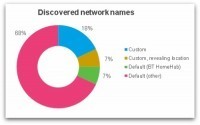With widespread popularity of mobile devices corporate espionage has never been so easy. See how a simple app can transform a smartphone into an espionage to...
Get Started for FREE
Sign up with Facebook Sign up with X
I don't have a Facebook or a X account

 Your new post is loading... Your new post is loading...
 Your new post is loading... Your new post is loading...
Current selected tag: 'Cybercrime goes mobile'. Clear
Do you always turn WiFi off on your smartphone before leaving the house or work? You might think there's no harm in having WiFi turned on but not connected to a network, but that's not necessarily the case.
A wireless device goes through a discovery process in which it attempts to connect to an available wireless network. This may either be ‘passive’ - listening for networks which are broadcasting themselves - or ‘active’ - sending out probe request packets in search of a network to connect to.
Most devices use both passive and active discovery in an attempt to connect to known/preferred networks. So it's very likely that your smartphone is broadcasting the names (SSIDs) of your favourite networks for anyone to see.
===> An ‘evil twin’ attack could even accomplish this without needing any knowledge of your WiFi password - very damaging for all of those who use mobile banking for instance! <===
Gust MEES: a MUST READ for anyone using m-Learning + "BYOD" and also any smartphone user...
|
The Norton Cybercrime Report is out for 2012! Cybercrime continues to have far-reaching effects and is increasingly a problem on mobile devices and in our social networks (where we seem to be less vigilant).
After surveying more than 13,000 consumers in 24 countries, the researchers found that the numbers of online adults increased by 20% from last year, and that cybercrime impacted just under ½ of them in the previous 12 months.
Read more, a MUST:
The Norton Cybercrime Report is out for 2012! Cybercrime continues to have far-reaching effects and is increasingly a problem on mobile devices and in our social networks (where we seem to be less vigilant).
After surveying more than 13,000 consumers in 24 countries, the researchers found that the numbers of online adults increased by 20 percent from last year, and that cybercrime impacted just under ½ of them in the previous 12 months. The total direct consumer cost was calculated to be $110 billion, slightly down from last year’s $114 billion (USD), with the average cost per victim down approximately 20 percent. The reason the overall cost remains so high is that the pool of victimized online adults grew more rapidly - in other words, less money, but from more victims.
|











one of interesting information, the video shows the security risk in daily life using smart phone. It is easy to call public to aware about the mobile security, also it contains lots of data which are useful